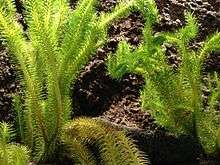Drepanophycaceae
| Drepanophycaceae Temporal range: Late Silurian to Late Devonian | |
|---|---|
 | |
| Artificial Baragwanathia model | |
| Fossil | |
| Scientific classification | |
| Kingdom: | Plantae |
| Division: | Lycopodiophyta |
| Class: | Lycopodiopsida |
| Order: | Drepanophycales |
| Family: | Drepanophycaceae † Kräusel & Weyland, 1949 |
| Genera | |
Drepanophycaceae is a family of extinct vascular plants of the division Lycopodiophyta[1] of Late Silurian to Late Devonian age (427 to 359 million years ago), found in North America, China, Russia, Europe, and Australia.
Description
The stems are several mm to several cm in diameter and several cm to several metres long, erect or arched, dichotomizing occasionally, furnished with true roots at the base.[2] Vascular bundle an exarch actinostele, tracheids of primitive annular or helical type (so-called G-type). Leaves are unbranched microphylls several mm to 2 cm or more long with a single prominent vascular thread, arranged spirally to randomly on the stem. Homosporous sporangia borne singly on the upper leaf surface or in an axillary position.[3]
Drepanophycaceae differs from a related family of the same period, Asteroxylaceae, in having vascularized microphylls;[3] see Drepanophycales for more details.
Genera
The genera in the family are:[2]
- Drepanophycus Göppert (type genus)
- microphylls short, tapering rapidly from wide base (thorn-shaped)
- microphylls arranged spirally or randomly on stem
- sporangia borne on upper surface of microphylls
- Baragwanathia Lang & Cookson
- microphylls long, not tapering over most of length (strap-shaped)
- microphylls arranged spirally on stem
- sporangia borne axially (whether on microphylls or on stem is not known)
Notes
- ↑ http://www.scientific-web.com/en/Biology/Plants/Lycopodiophyta/Drepanophycaceae.html Archived March 1, 2012, at the Wayback Machine.
- 1 2 Hueber 1992, p. 491 (Baragwanathia) and 492 (Drepanophycus)
- 1 2 See tables 2 & 3 in Gensel (1992) for list of these anatomical details.
References
- P. G. Gensel (1992), "Phylogenetic relationships of the zosterophylls and lycopsids: evidence from morphology, paleoecology, and cladistic methods of inference", Annals of the Missouri Botanical Garden, 79: 450–473, doi:10.2307/2399750
- F. M. Hueber (1992), "Thoughts on the early lycopsids and zosterophylls", Annals of the Missouri Botanical Garden, 79: 474–499, doi:10.2307/2399751